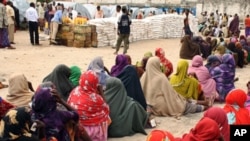The U.N. World Food Program has begun emergency airlifts of food to the drought-stricken Horn of Africa.
A WFP official has confirmed to VOA that the first plane, carrying more than 14 tons of food, landed Wednesday in the Somali capital, Mogadishu.
This is believed to be the first airlift of food to Somalia since the U.N. declared a famine in two southern regions of the country last week.
Additional aid flights are expected to go this week to eastern Ethiopia and northern Kenya, near the Somali border.
The airlifts were due to begin Tuesday but were delayed by what the WFP described as logistical problems in Kenya.
|
Definition of Famine: The word famine is a term that is not used lightly by humanitarian organizations. The United Nations describes a crisis as a famine only when the following conditions are met:
Current Famine:
|
U.N. officials have said more than 11 million people in the Horn of Africa are in need of emergency aid.
The U.N. is holding a donor's conference Wednesday in the Kenyan capital Nairobi, with the goal of raising up to $1.6 billion to combat the famine over the next 12 months.
In an interview with VOA Tuesday, WFP Director Josette Sheeran described Somalia as the epicenter of the crisis. She said one-third of the population there is facing starvation.
Sheeran, who visited Mogadishu last week, and said she had spoke to one woman who lost three children during a desperate walk to the capital, trying to find food.
On Tuesday, the U.N. refugee agency said 100,000 Somalis have arrived at Mogadishu-area camps in the past two months, and continue to come at a rate of 1,000 per day.
Thousands more are streaming across the border to camps in Kenya and Ethiopia. On Wednesday, the U.N. Children's Fund said it aims to vaccinate over 300,000 children in Kenya to prevent new outbreaks of disease.
U.N. access to southern Somalia - where the U.N. formally declared a famine last week - has been hampered by the militant Islamist group al-Shabab. The group controls large sections of the region and has denied that a famine is taking place, dismissing international assistance as political interference.
|
At the Dagahaley refugee camp in Dadaab, Kenya, families fleeing the famine in Somalia are given aid, but also face new challenges. VOA's Michael Onyiego visited the camp and took these pictures. |












